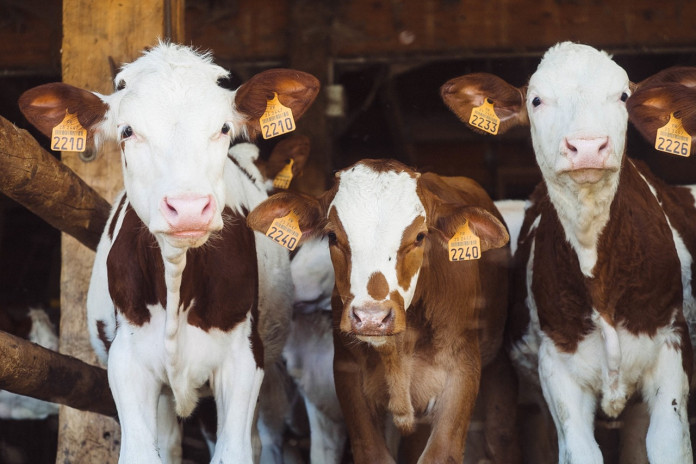Tagging livestock is an important part of animal identification but must be done properly to keep the animal from losing its tag or getting an infection. Before starting, make sure you have the proper ear tags and tag applicator.

1Secure the animal
Properly secure the animal to limit the animal’s head movement during the tagging process. Limiting head movement prevents improper tagging or injury to the animal or human doing the tagging.
For cattle, use a cattle chute with a head gate, halter and/or nose lead. Confine swine in a small pen, use hog boards, or a hog snare to completely secure the pig. For sheep and goats, properly grip the animal’s head to hold it in place.
2Disinfect
Proper hygiene is necessary to prevent infections. Use rubbing alcohol or disinfectant to clean the applicator as well as the tagging site in the ear.
3The applicator
Place each half of the tag onto the applicator. The stud must be completely onto the applicator pin and the panel/button portion must be under the opposite clip. Make sure the applicator pin is not bent or broken.Make sure the applicator is aligned before tagging the animal by closing the applicator to the point where the two halves meet; the stud should be centered with the hole.
Make sure the applicator is aligned before tagging the animal by closing the applicator to the point where the two halves meet; the stud should be centered with the hole.
4Tagging site
Identify the tagging site on the ear. Tags should be placed in the middle third of the ear between the upper and lower ribs. Tags placed too far outside the recommended area are prone to snagging and getting ripped out, while tags too far inside the animal’s ear could cause pinching or necrosis.
When applying electronic identification (EID) tags, apply tag with the visual panel, male portion, of the tag on the outside back of the ear with the EID button, female portion, of the tag inside the ear.
5Tagging
Position the applicator in the identified tagging site on the animal’s ear. Firmly and quickly close the applicator, and release.
Inspect the tag to verify it is in correctly, comfortably and securely. Record the necessary data on the animal.
6Watch for infection
Once the animal has been tagged, monitor the tagged area for infection. Apply hydrogen peroxide directly to the ear tag puncture for five to seven days to prevent infections. If a serious infection occurs, consult your veterinarian.
Sources: Livestock Tagging, Oklahoma State University Extension.
(Farm and Dairy is featuring a series of “101” columns throughout the year to help young and beginning farmers master farm living. From finances to management to machinery repair and animal care, farmers do it all.)
More Farming 101 columns:
- 6 tips for decision making on a family farm
- 8 tips to prepare your farm for agritourism
- How to plan for farm emergencies
- 7 keys to success on the farm
- 7 tips for healthy fair animals
- 5 tips to ensure livestock health before the fair
- 6 tips to keep your livestock parasite free
- 6 tips for vaccinating your livestock
- 5 tips to prevent dairy cow foot problems
- 6 common foot problems found in dairy cows
- Recognize, prevent heat stress in dairy cattle
- How to monitor your dairy herd
- How to start your own dairy farm
- 5 tips for sun safety in the field
- Employing youth for the summer
- What to do if a hay fire occurs
- How to prevent hay fires
- How to extend the life of your fence
- 10 safety tips for installing electric fences
- How to chose the right fence for your farm
- How to create a fencing plan
- 7 steps for easy sprayer calibration
- Prepare for planting season, Part 2: Calibration
- Prepare for planting season, Part 1: The Basics
- 7 tips to improve security on your farm
- 5 tips to protect your farmland
- 3 measures to deal with severe farm debt
- How to buy time to catch up on farm debt
- 6 tips to manage income on the farm
- 5 tips to recognize and deal with farm stress
- How to prepare a livestock birthing kit
- 5 tips for marketing your farm
- How to develop farm mission, vision statements
- 5 tips for setting farm goals
- 2 types of livestock insurance policies
- 6 things you need to know about WFRP plans
- 3 basics of crop insurance
- How does liability insurance work on the farm?
- Why do I need farm insurance?
- How to understand and use Ohio’s CAUV
- How to utilize the Pa. Clean and Green Act
- 9 tips for filing farm taxes
- 8 reasons record keeping for taxes is essential
- 5 tips for post-harvest storage
- 7 tips for family meetings on the farm
- 4 tips for balancing your farm and family
- 4 tips for communicating on the family farm
- 4 tips for firing an employee
- 6 tips for keeping good farm help
- 4 tips for recruiting farm labor
- 5 general farm labor laws
- 4 tips for employing minors
- 4 tips for PTO safety
- 5 things young farmers should know about finances
- The farm balance sheet
- 5 items for your farm’s cash flow statement
- Personal and business records: Keep them separate
- What to include in your farm business plan
- How to approach a lender: Tips for getting a farm loan
- How to use microloans to get your farm started
- Saving for the future: 6 tips for young farmers
- How to create a farm safety kit
- 5 tips for child safety on the farm
- 4 tips for transporting livestock
- 5 ways to better understand tractor stability
- 6 farm equipment hacks










